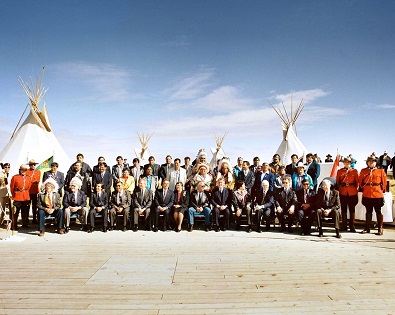Photo posted by FSIN on conference Facebook page.
Prosperity through partnerships – that’s the theme for a two-day conference hosted by the Federation of Sovereign Indigenous Nations at TCU Place in Saskatoon.
The conference, which started on Wednesday, brought together First Nations leaders and technicians, administrators from rural and urban municipalities and the corporate community to look at how all parties can work together to increase the economic prosperity and well-being of both the Saskatchewan First Nations and the Saskatchewan public.
Since 1992 when the Treaty Land Entitlement Framework Agreement was signed with Canada and the province of Saskatchewan, a number of First Nations have been purchasing land for economic and traditional purposes. Saskatchewan has become a leader in the creation of new reserves.
In rural areas, agricultural and resource-based opportunities are being realized on the over one million acres of reserves that have been created. Since 1992, over 50 urban reserves have been established.
Muskeg Lake Cree Nation was one of the first reserves in Canada to have an urban reserve created when they purchased 35 acres in the Sutherland area of Saskatoon. After a few years of negotiations with the city, the province and Canada, the First Nation gained reserve status on the land. In the last 30 years, numerous First Nation businesses have set up shop on the urban reserve, with organizations such as the FSIN, Saskatoon Tribal Council and SIGA having their head offices in the business complex.
Muskeg Cree Nation urban councillor Paul Ledoux says it took some time to get the reserve status on the property, but it wasn’t without the help of the city of Saskatoon. The two sides negotiated an agreement for services such as fire protection, police service, garbage collection and also for taxes. Muskeg Lake has their own tax regime and collects business tax, which in turn helps pay for the city services.
Ledoux says the partnership with the city has had a positive impact for both First Nations people and non-Aboriginal people.
“I think it’s important that our First Nation communities understand the planning process and goals and objectives of acquiring lands through specific claims or the TLE process, and the involvement of the municipalities from the start is very important as well,” he said.
Ledoux says building those partnerships at the very start is key to having a long-standing relationship with municipal neighbors. He says the First Nation communities that are buying land for reserve creation, especially in rural areas, should meet early with municipal governments and let them know what their community’s dynamics are, and their plans for the future. He also says the values of the First Nations are not that much different than those in a municipality.
“We want communities that are safe communities, we want people to work and prosper and have good housing, but we will continue to have challenges unless we all step forward,” he said.
Ledoux says their long-standing partnership with the City of Saskatoon with the Sutherland urban reserve has helped them attain reserve status on another parcel on the west side of the city.
The reserve creation file had been stuck in channels at INAC in Ottawa, so Chief Clifford Tawpasin Jr. and former Saskatoon Mayor Don Atchison went to Ottawa to meet with government officials on the holdup of the land being turned to reserve.
“The mayor told government officials the city supports these types of development with First Nations; why does it take so long?”
He says when you can have a mayor of a major city go with your Chief to Ottawa to speak on the First Nation’s behalf that speaks volumes about how the two have worked together and valued their partnership.
The conference will also address how to achieve best results through planning and coordination with neighboring communities and urban planning.
